人教版高中英语必修三《Unit 3 The Million Pound Bank-Note》period 2(45张)
文档属性
| 名称 | 人教版高中英语必修三《Unit 3 The Million Pound Bank-Note》period 2(45张) |  | |
| 格式 | zip | ||
| 文件大小 | 1.3MB | ||
| 资源类型 | 教案 | ||
| 版本资源 | 人教版(新课程标准) | ||
| 科目 | 英语 | ||
| 更新时间 | 2016-11-05 17:21:38 | ||
图片预览

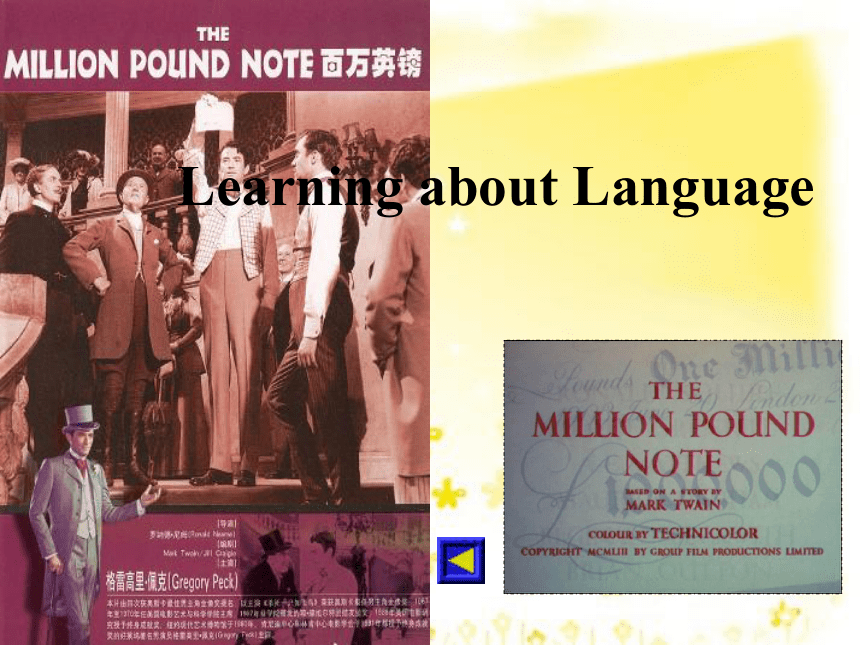

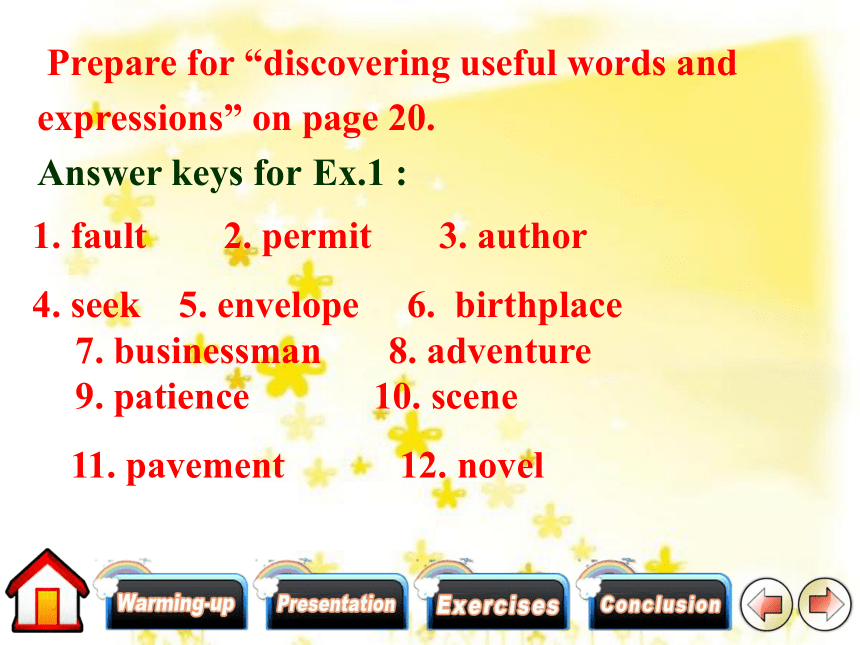

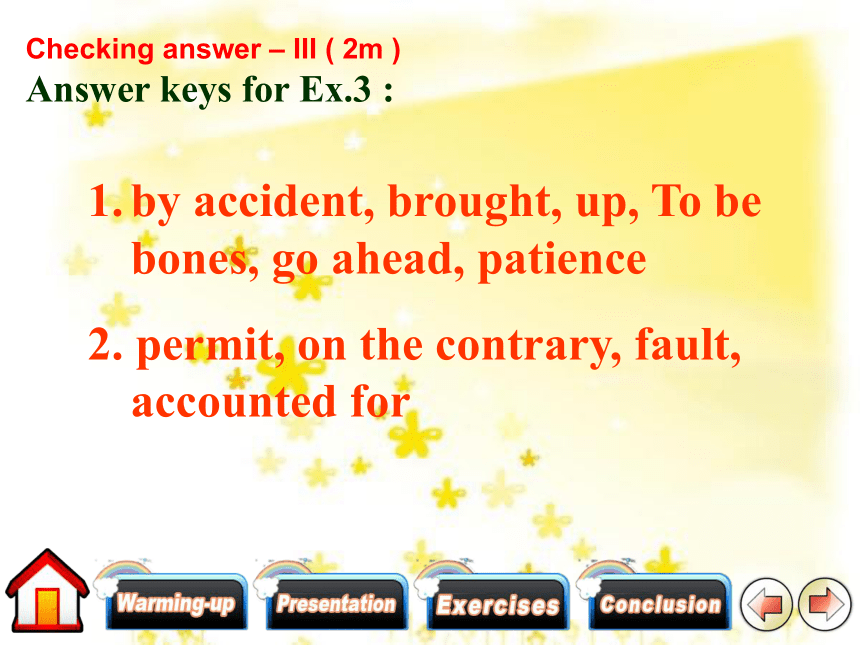

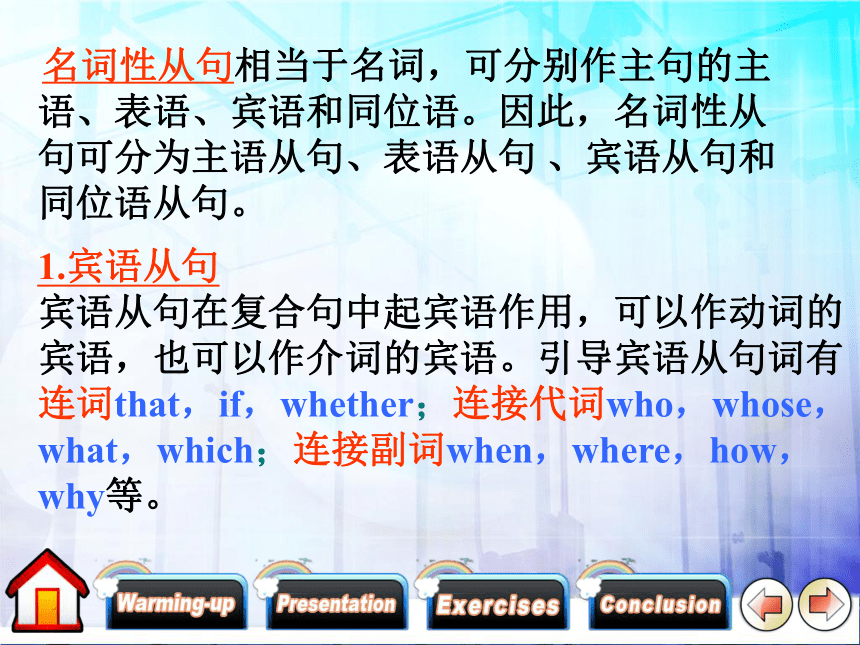
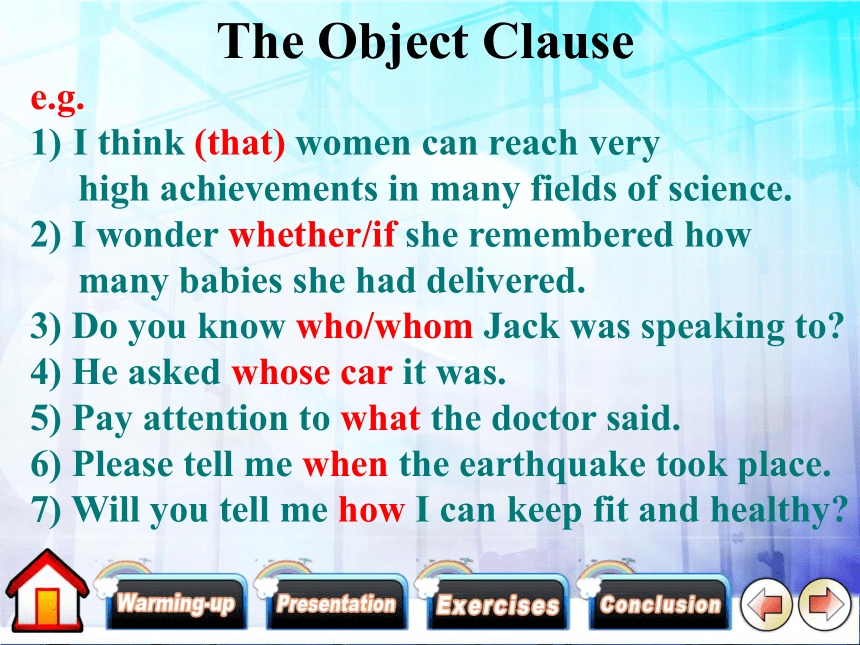



文档简介
课件45张PPT。The Million Pound Bank NotePeriod twoLearning about LanguageWarming Up Prepare for “discovering useful words and expressions” on page 20.
Answer keys for Ex.1 :1. fault 2. permit 3. author
4. seek 5. envelope 6. birthplace 7. businessman 8. adventure 9. patience 10. scene
11. pavement 12. novelChecking answer – II (2m) Answer keys for Ex.2 :Checking answer – III ( 2m ) Answer keys for Ex.3 :by accident, brought, up, To be bones, go ahead, patience
2. permit, on the contrary, fault, accounted for GrammarNoun clauses as the object and predicative
名词性从句 宾语从句 表语从句Presentation 名词性从句相当于名词,可分别作主句的主语、表语、宾语和同位语。因此,名词性从句可分为主语从句、表语从句 、宾语从句和同位语从句。
1.宾语从句
宾语从句在复合句中起宾语作用,可以作动词的宾语,也可以作介词的宾语。引导宾语从句词有连词that,if,whether;连接代词who,whose,what,which;连接副词when,where,how, why等。The Object Clausee.g.
I think (that) women can reach very
high achievements in many fields of science.
2) I wonder whether/if she remembered how
many babies she had delivered.
3) Do you know who/whom Jack was speaking to?
4) He asked whose car it was.
5) Pay attention to what the doctor said.
6) Please tell me when the earthquake took place.
7) Will you tell me how I can keep fit and healthy?The Object Clause做动词的宾语 (1)大部分宾语从句直接跟在动词后:
e.g. He doesn't know where the post office is.
(2)有些宾语从句前要有间接宾语:
e.g. He told me what I should read.(3)如果宾语从句后面有宾语补足语,要使用形式宾语 it 而将从句放到补足语后面;
e.g. I thought it strange that he failed to call me.
我觉得奇怪:他没给我打电话。
(4)在think, believe, suppose, expect等动词之后的宾语从句中,如果从句谓语是否定含义,则不用否定形式,而将主句谓语动词think等变为否定形式;
e.g. I don’t think you are right.
我想你是不对的。(5) 在think,believe,imagine,suppose,guess,hope等动词以及 I’m afraid 等后,可用so代替一个肯定的宾语从句,还可用not代替一个否定的宾语从句:
e.g. 一Do you believe it will clear up?你认为天气会转晴吗?
一I believe so. 我认为会这样。
I don't believe so.(或I believe not.)
我认为不会这样。
(1)一般情况下,宾语从句直接跟在谓语后;
e.g. Did she say anything about how we should do the work?
(2) that引导的宾语从句只有在except, in, but, besides等少数介词后偶尔可能用到;
e.g. Your article is all right except that it is too long.
(3)有时在介词和其宾语从句的中间加形式宾语 it;
e.g. I’ll see to it that everything is ready.
做介词的宾语3. what, which, who, whom, whose引导的表语从句
连接代词what,which,who,whom,whose除在句子中起连接作用外,还可在从句中从当主语、表语、定语,且各有各的词义。
e.g. Tom is no longer what he used to be.
The question is which of us should come first.
The problem is who is really fit for the hard job.
The important thing is whose name should be put on the top of the list.The Predicative Clause
that 引导的表语从句
that 仅起连接作用,无意义,在句中不作任何成分,通常不可省略。这种从句往往是对主句主语的内容起进一步解释的作用。
e.g. The chance is that one smoker in four will die from smoking.
2. whether 引导的表语从句
连接词whether起连接作用, 意为“是否、究竟、到底”(注意:if不能引导表语从句) 在句中也不作任何成分。
e.g. The question is whether what man will turn up in time.2. 表语从句-在从句中作表语的从句称作表语从句。4. where, when, why, how引导的表语从句
连接副词where, when, why, how除在句中起连接作用外,在从句中还充当时间、地点、方式、原因状语,本身具有词义。
e.g. That’s where I can’t agree with you.
This is why Sara was late for the meeting.
This is how they overcome the difficulties.
My strongest memory is when I attended an American wedding.5. 其他连词as if, because, as, as though 引导的表语从句
because引导表语从句通常只用于“This/That/It is because…”结构中。
as if/though引导的表语从句常置于连系动词look, seem, sound, be, become等后面,常用虚拟语气,表示不存在的动作或状态。
e.g. It sounds as if/though somebody was knocking at the door.
My anger is because you haven’t written to me for a long time.Exercises 1.Go and get your coat.It's_______you left it. A.there B.where C.there were D.where there
2.The problem is_______ he has enough time. A.if B.whether C./ D.that
3.He made a promise_______ he would help me. A.what B.when C.that D.which
4.I remember_______ this used to be a quiet village. A.how B.when C.where D.what
5.It is generally considered unwise to give a child_______ he or she wants. A.however B.whatever C.whichever D.whereverBBCBBPractice – choosing ( 10m )高考链接1. —Are you still thinking about yesterday's game?
—Oh, that‘s_______ .
A. what makes me feel excited
B. whatever I feel excited about
C. how I feel about it
D. when I feel excited
A解析: 这是由what 引导的一个表语从句,在从句中充当主语,这句话的意思为:那是使我感到兴奋的事。故答案为A。2. —I drove to Zhuhai for the air show last week.
—Is that_______ you had a few days off?
A. why B. when C. what D. where
解析:这是一个由why引导的表语从句,表示原因.这句话的意思是"这就是你离开的原因吗?"。故答案为A。
A
3.Perseverance is a kind of quality and that’s _______ it takes to do anything well.
A. what B. that C. which D. why
解析:what在表语从句中作takes的宾语,构成"It takes sth. to do sth."的句型。答案为A。
A4.When you answer questions in a job interview, please remember the golden rule: Always give the monkey exactly_______ he wants .
A.what B.which C.when D.that 解析:这是一个宾语从句,wants后面缺少宾语,Always give the monkey exactly what he wants是一句谚语,意思是"永远给予他人他确实想要的东西"。故答案为A。A非谓语动词的用法区别非谓语动词的用法区别动词不定式与动名词
动词不定式与分词
动名词与现在分词
现在分词与过去分词
其它情况一、动词不定式与动名词 从结构上看,两者不同之处有:动名词前可用介词,它还可以被名词所有格(或代词)修饰;不定式前通常不用介词,更不能被名词所有格(或代词)修饰。
在实际应用中,有下列各点值得注意:1. 作主语或表语时一般说来,在表示比较抽象的一般行为时多用动名词;在表示具体的动作,特别是将来的动作时,多用不定式。Smoking is not allowed here. (表习惯、爱好、或抽象的动作、经常做的事情。)
To smoke so much is not good for you. (表具体的、一次性动作、要做的事情。)
Their jog is building houses. (抽象、经常的动作)
Their work is to build another bridge across the river. (具体、要做的动作)2. 作宾语时1)动名词可作动词和介词的宾语
2)动词不定式一般作动词的宾语,疑问词+to do
可作介词的宾语。They preferred walking to school to cycling.
They preferred to stay at home rather than go out in such hot weather.
Our English teacher often gives us some advice on how to learn English.1)作动词宾语时,两种结构在意义上有时差别不大,这样的动词有:
like, hate, prefer, begin, start, continue, intend, attempt, propose, deserve, need, can’t bear, 等。Do you like playing (to play) chess?
When did you begin learning (to learn) English?
Your suit needs ironing ( to be ironed). 注意【1】在like ,hate, prefer 等动词之后,如果表示一般倾向,多用动名词作宾语;如指特定的或某次行动,则用不定式更多一些。I like reading books of this kind, but I don’t like to read that book.
She prefer walking to cycling.
I prefer to stay at home today.注意【2】在begin, start, cease后,如果表示有意识地开始(停止)做某事,多用动名词;如果动作自动或突然开始(停止),则多用不定式。He began talking about his plan for summer holiday.
Suddenly it began to rain.
We started working on the program in 2001.
The factory has ceased making motorcycles.
After that she ceased to worry about her daughter.2)作动词宾语时,两种结构在意义上有时差别很大,这样的动词有:
remember, forget, regret, stop, mean, try, 等。
remember/ forget/ regret +v-ing 表已经发生的动作,remember/ forget/ regret + v-ing 表动作还没有发生。
mean doing 意思是……;意味着……
mean to do 意欲,打算要做……
stop to do 停下来要做……
stop doing 停止正在做的动作
try doing 试着做…… try to do sth. 试图做……
3) 在动词want , require, need, 等后
◎动词不定式(短语)作宾语时,用人作主语;
◎动名词作宾语时(=to be done),用物作主语。Someone needs to see you , sir.
The wall needs repairing(= to be repaired).
I want to go to the barber’s because my hair wants cutting(= to be cut).4)动名词作定语表示所修饰名词的用途,常常放在所修饰名词之前;而动词不定式作定语表未发生的动作,常常放在所修饰名词之后。We have various kinds of clothes for you to choose from.
His attempt to solve the difficult problem failed again.
These passages may be used as listening materials.
Mr Wang suffers from insomnia, he has to take a sleeping tablets before going to bed.二、动词不定式与分词一般说来,动词不定式表主动、将来;
现在分词 表主动、进行;
过去分词 表被动、完成。一、动词不定式与分词作宾补的区别在see, hear, notice等感官动词和have等使役动词之后,既可用分词也可用不定式构成复合宾语。区别是:1)作现在分词时,表示动作正在进行发生,其含义相当于进行时态;2)用不定式表示动作已经发生,动作的过程已经结束;3)用过去分词表示一个被动动作。I saw him go upstairs. (动作全过程)
I saw him going upstairs. (动作正在进行)
-Don’t have me waiting for you outside ? -I won’t. I just have my hair cut.三、动名词与现在分词动名词与现在分词同形(v-ing),但是,两者有各自的语法名称和作用:
1)当v-ing形式在句中作主语、宾语、表语、定语时,被称为动名词。
2)当v-ing形式在句中作状语、宾语补足语、表语、定语时,被称为现在分词。
可见,二者都可以作表语和定语。(一)作表语时的区别1、现在分词作表语表示主语的特征或属性;
2、动名词作表语表示主语的内容、功能等。The news is exciting. (现在分词表特征)
Her work is nursing children. (动名词表内容)
Her favorite job is teaching English.动名词表内容)
The story sounds interesting. (现在分词表特征)(二)作定语时的区别1、动名词作定语表示所修饰名词的作用、用途等,常常放在所修饰名词之前;
2、现在分词作定语表示它所修饰的名词的动作,被修饰名词与现在分词在逻辑上是主谓关系,说明所修饰的词、所代表的人或物所做的动作或特征;单个分词作定语,位于所修饰的名词之前,分词短语作定语放在所修饰的名词之后。1.flying fish = fish which can fly 飞鱼 (现在分词)
2.flying suit = suit for flying 飞行衣 (动名词)四、现在分词与过去分词两者之间的区别主要体现在时态和语态上:
(1)在时态上:现在分词表示正在进行,而过去分词表示已经完成。
(2)在语态上:现在分词表示主动;而过去分词表示被动。
总之,现在分词表主动、进行;
过去分词表被动、完成。
在句法功能上它们都可以作定语、表语、状语和宾补,它们的具体区别如下:1、作定语时1.现在分词作定语表示正在进行的动作,或表示经常性的动作, 或现在 (或当时) 的状态;
2.过去分词作定语时,过去分词所表示的动作可以在谓语所表示的动作之前发生,也可以是没有一定的时间性。The meeting held last week is very important.
Tell the children playing there not to make so much noise.
They lived in a room facing (= that faced) the south.
I hate to see letters written in pencil.2、作表语时现在分词多表示主语所具有的特征或属性;过去分词多表示主语所处的状态。现在分词表示“令人……的”,过去分词表示“感到……”.常见的分词有:amazed / amazing, excited / exciting, bored / boring, annoyed / annoying, interested / interesting, pleased / pleasing, tired / tiring, surprised / surprising, worried/ worrying , satisfied / satisfying, amused / amusingThe news was exciting. He appeared satisfied with my answer.3、作宾语补足语时现在分词与句子的宾语是主动关系,它所表示的动作往往正在进行;
过去分词与句子的宾语是被动关系,它所表示的动作往往已经完成。I found them painting the windows. (现在分词表主动、进行)
I found the windows painted. (过去分词表被动、完成)五、其它区别现在分词的被动式(being done)强调某一动作正在被进行中;
过去分词表示某一(被动)动作已经(结束)完成,不强调时间概念;
不定式的被动式(to be done)表示一个还没有发生的被动动作。The building being repaired is our library.
Xiao Wang fell asleep with the window opening and the curtain drawn.
Hi, Lucy, the boss has another document to be typed.HomeworkRecite the key sentences on the grammar-noun clauses as the object and predicative.
Preview the next period.Conclusion
Answer keys for Ex.1 :1. fault 2. permit 3. author
4. seek 5. envelope 6. birthplace 7. businessman 8. adventure 9. patience 10. scene
11. pavement 12. novelChecking answer – II (2m) Answer keys for Ex.2 :Checking answer – III ( 2m ) Answer keys for Ex.3 :by accident, brought, up, To be bones, go ahead, patience
2. permit, on the contrary, fault, accounted for GrammarNoun clauses as the object and predicative
名词性从句 宾语从句 表语从句Presentation 名词性从句相当于名词,可分别作主句的主语、表语、宾语和同位语。因此,名词性从句可分为主语从句、表语从句 、宾语从句和同位语从句。
1.宾语从句
宾语从句在复合句中起宾语作用,可以作动词的宾语,也可以作介词的宾语。引导宾语从句词有连词that,if,whether;连接代词who,whose,what,which;连接副词when,where,how, why等。The Object Clausee.g.
I think (that) women can reach very
high achievements in many fields of science.
2) I wonder whether/if she remembered how
many babies she had delivered.
3) Do you know who/whom Jack was speaking to?
4) He asked whose car it was.
5) Pay attention to what the doctor said.
6) Please tell me when the earthquake took place.
7) Will you tell me how I can keep fit and healthy?The Object Clause做动词的宾语 (1)大部分宾语从句直接跟在动词后:
e.g. He doesn't know where the post office is.
(2)有些宾语从句前要有间接宾语:
e.g. He told me what I should read.(3)如果宾语从句后面有宾语补足语,要使用形式宾语 it 而将从句放到补足语后面;
e.g. I thought it strange that he failed to call me.
我觉得奇怪:他没给我打电话。
(4)在think, believe, suppose, expect等动词之后的宾语从句中,如果从句谓语是否定含义,则不用否定形式,而将主句谓语动词think等变为否定形式;
e.g. I don’t think you are right.
我想你是不对的。(5) 在think,believe,imagine,suppose,guess,hope等动词以及 I’m afraid 等后,可用so代替一个肯定的宾语从句,还可用not代替一个否定的宾语从句:
e.g. 一Do you believe it will clear up?你认为天气会转晴吗?
一I believe so. 我认为会这样。
I don't believe so.(或I believe not.)
我认为不会这样。
(1)一般情况下,宾语从句直接跟在谓语后;
e.g. Did she say anything about how we should do the work?
(2) that引导的宾语从句只有在except, in, but, besides等少数介词后偶尔可能用到;
e.g. Your article is all right except that it is too long.
(3)有时在介词和其宾语从句的中间加形式宾语 it;
e.g. I’ll see to it that everything is ready.
做介词的宾语3. what, which, who, whom, whose引导的表语从句
连接代词what,which,who,whom,whose除在句子中起连接作用外,还可在从句中从当主语、表语、定语,且各有各的词义。
e.g. Tom is no longer what he used to be.
The question is which of us should come first.
The problem is who is really fit for the hard job.
The important thing is whose name should be put on the top of the list.The Predicative Clause
that 引导的表语从句
that 仅起连接作用,无意义,在句中不作任何成分,通常不可省略。这种从句往往是对主句主语的内容起进一步解释的作用。
e.g. The chance is that one smoker in four will die from smoking.
2. whether 引导的表语从句
连接词whether起连接作用, 意为“是否、究竟、到底”(注意:if不能引导表语从句) 在句中也不作任何成分。
e.g. The question is whether what man will turn up in time.2. 表语从句-在从句中作表语的从句称作表语从句。4. where, when, why, how引导的表语从句
连接副词where, when, why, how除在句中起连接作用外,在从句中还充当时间、地点、方式、原因状语,本身具有词义。
e.g. That’s where I can’t agree with you.
This is why Sara was late for the meeting.
This is how they overcome the difficulties.
My strongest memory is when I attended an American wedding.5. 其他连词as if, because, as, as though 引导的表语从句
because引导表语从句通常只用于“This/That/It is because…”结构中。
as if/though引导的表语从句常置于连系动词look, seem, sound, be, become等后面,常用虚拟语气,表示不存在的动作或状态。
e.g. It sounds as if/though somebody was knocking at the door.
My anger is because you haven’t written to me for a long time.Exercises 1.Go and get your coat.It's_______you left it. A.there B.where C.there were D.where there
2.The problem is_______ he has enough time. A.if B.whether C./ D.that
3.He made a promise_______ he would help me. A.what B.when C.that D.which
4.I remember_______ this used to be a quiet village. A.how B.when C.where D.what
5.It is generally considered unwise to give a child_______ he or she wants. A.however B.whatever C.whichever D.whereverBBCBBPractice – choosing ( 10m )高考链接1. —Are you still thinking about yesterday's game?
—Oh, that‘s_______ .
A. what makes me feel excited
B. whatever I feel excited about
C. how I feel about it
D. when I feel excited
A解析: 这是由what 引导的一个表语从句,在从句中充当主语,这句话的意思为:那是使我感到兴奋的事。故答案为A。2. —I drove to Zhuhai for the air show last week.
—Is that_______ you had a few days off?
A. why B. when C. what D. where
解析:这是一个由why引导的表语从句,表示原因.这句话的意思是"这就是你离开的原因吗?"。故答案为A。
A
3.Perseverance is a kind of quality and that’s _______ it takes to do anything well.
A. what B. that C. which D. why
解析:what在表语从句中作takes的宾语,构成"It takes sth. to do sth."的句型。答案为A。
A4.When you answer questions in a job interview, please remember the golden rule: Always give the monkey exactly_______ he wants .
A.what B.which C.when D.that 解析:这是一个宾语从句,wants后面缺少宾语,Always give the monkey exactly what he wants是一句谚语,意思是"永远给予他人他确实想要的东西"。故答案为A。A非谓语动词的用法区别非谓语动词的用法区别动词不定式与动名词
动词不定式与分词
动名词与现在分词
现在分词与过去分词
其它情况一、动词不定式与动名词 从结构上看,两者不同之处有:动名词前可用介词,它还可以被名词所有格(或代词)修饰;不定式前通常不用介词,更不能被名词所有格(或代词)修饰。
在实际应用中,有下列各点值得注意:1. 作主语或表语时一般说来,在表示比较抽象的一般行为时多用动名词;在表示具体的动作,特别是将来的动作时,多用不定式。Smoking is not allowed here. (表习惯、爱好、或抽象的动作、经常做的事情。)
To smoke so much is not good for you. (表具体的、一次性动作、要做的事情。)
Their jog is building houses. (抽象、经常的动作)
Their work is to build another bridge across the river. (具体、要做的动作)2. 作宾语时1)动名词可作动词和介词的宾语
2)动词不定式一般作动词的宾语,疑问词+to do
可作介词的宾语。They preferred walking to school to cycling.
They preferred to stay at home rather than go out in such hot weather.
Our English teacher often gives us some advice on how to learn English.1)作动词宾语时,两种结构在意义上有时差别不大,这样的动词有:
like, hate, prefer, begin, start, continue, intend, attempt, propose, deserve, need, can’t bear, 等。Do you like playing (to play) chess?
When did you begin learning (to learn) English?
Your suit needs ironing ( to be ironed). 注意【1】在like ,hate, prefer 等动词之后,如果表示一般倾向,多用动名词作宾语;如指特定的或某次行动,则用不定式更多一些。I like reading books of this kind, but I don’t like to read that book.
She prefer walking to cycling.
I prefer to stay at home today.注意【2】在begin, start, cease后,如果表示有意识地开始(停止)做某事,多用动名词;如果动作自动或突然开始(停止),则多用不定式。He began talking about his plan for summer holiday.
Suddenly it began to rain.
We started working on the program in 2001.
The factory has ceased making motorcycles.
After that she ceased to worry about her daughter.2)作动词宾语时,两种结构在意义上有时差别很大,这样的动词有:
remember, forget, regret, stop, mean, try, 等。
remember/ forget/ regret +v-ing 表已经发生的动作,remember/ forget/ regret + v-ing 表动作还没有发生。
mean doing 意思是……;意味着……
mean to do 意欲,打算要做……
stop to do 停下来要做……
stop doing 停止正在做的动作
try doing 试着做…… try to do sth. 试图做……
3) 在动词want , require, need, 等后
◎动词不定式(短语)作宾语时,用人作主语;
◎动名词作宾语时(=to be done),用物作主语。Someone needs to see you , sir.
The wall needs repairing(= to be repaired).
I want to go to the barber’s because my hair wants cutting(= to be cut).4)动名词作定语表示所修饰名词的用途,常常放在所修饰名词之前;而动词不定式作定语表未发生的动作,常常放在所修饰名词之后。We have various kinds of clothes for you to choose from.
His attempt to solve the difficult problem failed again.
These passages may be used as listening materials.
Mr Wang suffers from insomnia, he has to take a sleeping tablets before going to bed.二、动词不定式与分词一般说来,动词不定式表主动、将来;
现在分词 表主动、进行;
过去分词 表被动、完成。一、动词不定式与分词作宾补的区别在see, hear, notice等感官动词和have等使役动词之后,既可用分词也可用不定式构成复合宾语。区别是:1)作现在分词时,表示动作正在进行发生,其含义相当于进行时态;2)用不定式表示动作已经发生,动作的过程已经结束;3)用过去分词表示一个被动动作。I saw him go upstairs. (动作全过程)
I saw him going upstairs. (动作正在进行)
-Don’t have me waiting for you outside ? -I won’t. I just have my hair cut.三、动名词与现在分词动名词与现在分词同形(v-ing),但是,两者有各自的语法名称和作用:
1)当v-ing形式在句中作主语、宾语、表语、定语时,被称为动名词。
2)当v-ing形式在句中作状语、宾语补足语、表语、定语时,被称为现在分词。
可见,二者都可以作表语和定语。(一)作表语时的区别1、现在分词作表语表示主语的特征或属性;
2、动名词作表语表示主语的内容、功能等。The news is exciting. (现在分词表特征)
Her work is nursing children. (动名词表内容)
Her favorite job is teaching English.动名词表内容)
The story sounds interesting. (现在分词表特征)(二)作定语时的区别1、动名词作定语表示所修饰名词的作用、用途等,常常放在所修饰名词之前;
2、现在分词作定语表示它所修饰的名词的动作,被修饰名词与现在分词在逻辑上是主谓关系,说明所修饰的词、所代表的人或物所做的动作或特征;单个分词作定语,位于所修饰的名词之前,分词短语作定语放在所修饰的名词之后。1.flying fish = fish which can fly 飞鱼 (现在分词)
2.flying suit = suit for flying 飞行衣 (动名词)四、现在分词与过去分词两者之间的区别主要体现在时态和语态上:
(1)在时态上:现在分词表示正在进行,而过去分词表示已经完成。
(2)在语态上:现在分词表示主动;而过去分词表示被动。
总之,现在分词表主动、进行;
过去分词表被动、完成。
在句法功能上它们都可以作定语、表语、状语和宾补,它们的具体区别如下:1、作定语时1.现在分词作定语表示正在进行的动作,或表示经常性的动作, 或现在 (或当时) 的状态;
2.过去分词作定语时,过去分词所表示的动作可以在谓语所表示的动作之前发生,也可以是没有一定的时间性。The meeting held last week is very important.
Tell the children playing there not to make so much noise.
They lived in a room facing (= that faced) the south.
I hate to see letters written in pencil.2、作表语时现在分词多表示主语所具有的特征或属性;过去分词多表示主语所处的状态。现在分词表示“令人……的”,过去分词表示“感到……”.常见的分词有:amazed / amazing, excited / exciting, bored / boring, annoyed / annoying, interested / interesting, pleased / pleasing, tired / tiring, surprised / surprising, worried/ worrying , satisfied / satisfying, amused / amusingThe news was exciting. He appeared satisfied with my answer.3、作宾语补足语时现在分词与句子的宾语是主动关系,它所表示的动作往往正在进行;
过去分词与句子的宾语是被动关系,它所表示的动作往往已经完成。I found them painting the windows. (现在分词表主动、进行)
I found the windows painted. (过去分词表被动、完成)五、其它区别现在分词的被动式(being done)强调某一动作正在被进行中;
过去分词表示某一(被动)动作已经(结束)完成,不强调时间概念;
不定式的被动式(to be done)表示一个还没有发生的被动动作。The building being repaired is our library.
Xiao Wang fell asleep with the window opening and the curtain drawn.
Hi, Lucy, the boss has another document to be typed.HomeworkRecite the key sentences on the grammar-noun clauses as the object and predicative.
Preview the next period.Conclusion
同课章节目录
